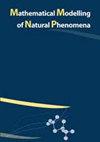Wave blocking in a bistable system by local introduction of a population~: application to sterile insect techniques on mosquito populations p, li { white-space: pre-wrap; }
IF 2.1
4区 数学
Q2 MATHEMATICAL & COMPUTATIONAL BIOLOGY
引用次数: 3
Abstract
The Sterile Insect Technique (SIT) is a classic vector control method that has been successfully applied to fight against diverse insect plagues since the 1950s . In recent years, this strategy has been used to control mosquito populations, in order to limit the spread of the diseases they transmit. In this paper, we consider a system of reaction-diffusion equations to model the mosquito population and study the effect of the release of sterile mosquito males. Then we propose to analyze the release in a limited area inside a wider area containing natural mosquito population. We are interested in protecting a mosquito free region from invasion by mosquitoes from an exterior domain by controlling the population in a release band at the border between the two regions: we construct a barrier blocking the invasion of mosquitoes from the exterior. We adapt the geometric method of Lewis and Keener in this framework and extend their main result to find relations on the size of the release region and the density of the released sterile males that allow us to block the invasion. Numerical simulations are also performed to illustrate our results.局部引入种群在双稳态系统中的波阻挡作用:在蚊虫种群不育昆虫技术中的应用[j], [j]}
昆虫不育技术(SIT)是一种经典的媒介控制方法,自20世纪50年代以来已成功应用于对抗各种昆虫瘟疫。近年来,这一策略已被用于控制蚊子的数量,以限制它们传播的疾病的传播。在本文中,我们考虑了一个反应扩散方程组来模拟蚊子种群,并研究了释放不育雄蚊的影响。然后,我们建议在包含自然蚊子种群的更大区域内,分析有限区域内的释放。我们感兴趣的是通过控制两个地区边界释放带中的种群来保护无蚊区免受外部蚊子的入侵:我们建造了一个屏障,阻止蚊子从外部入侵。我们在这个框架中采用了Lewis和Keener的几何方法,并扩展了他们的主要结果,以找到释放区域的大小和释放的不育雄性的密度之间的关系,从而使我们能够阻止入侵。还进行了数值模拟来说明我们的结果。
本文章由计算机程序翻译,如有差异,请以英文原文为准。
求助全文
约1分钟内获得全文
求助全文
来源期刊

Mathematical Modelling of Natural Phenomena
MATHEMATICAL & COMPUTATIONAL BIOLOGY-MATHEMATICS, INTERDISCIPLINARY APPLICATIONS
CiteScore
5.20
自引率
0.00%
发文量
46
审稿时长
6-12 weeks
期刊介绍:
The Mathematical Modelling of Natural Phenomena (MMNP) is an international research journal, which publishes top-level original and review papers, short communications and proceedings on mathematical modelling in biology, medicine, chemistry, physics, and other areas. The scope of the journal is devoted to mathematical modelling with sufficiently advanced model, and the works studying mainly the existence and stability of stationary points of ODE systems are not considered. The scope of the journal also includes applied mathematics and mathematical analysis in the context of its applications to the real world problems. The journal is essentially functioning on the basis of topical issues representing active areas of research. Each topical issue has its own editorial board. The authors are invited to submit papers to the announced issues or to suggest new issues.
Journal publishes research articles and reviews within the whole field of mathematical modelling, and it will continue to provide information on the latest trends and developments in this ever-expanding subject.
 求助内容:
求助内容: 应助结果提醒方式:
应助结果提醒方式:


